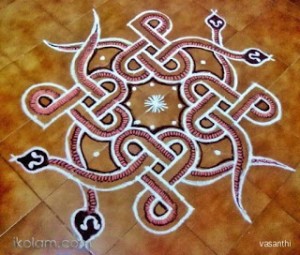 Snakes are part of the fabric of Hinduism, since Hinduism began its existence in a place where one of the biggest threats to human life was snakes. You may have heard of Naga, which are a powerful mythological race of snakes. On Nag Panchami, snakes of all varieties are honored and given offerings to buy protection from the snake’s mystical and physical powers.
Snakes are part of the fabric of Hinduism, since Hinduism began its existence in a place where one of the biggest threats to human life was snakes. You may have heard of Naga, which are a powerful mythological race of snakes. On Nag Panchami, snakes of all varieties are honored and given offerings to buy protection from the snake’s mystical and physical powers.
This year it falls on August 1st, a Friday. (In Gujarat the festival takes place 15 days later).
Snakes in Mythology
Snakes and powerful snake-like creatures play a part in much of Hindu mythology. The Mahabharata opens with a conversation between snakes. They appear in the ancient stories called Puranas and in the Vedas. Vishnu is often seen resting on a snake with six heads. Shiva has a live snake around his neck. Some stories say that the earth rests on the head of a giant snake. Naga have inspired modern day legends as well and often appear as characters in video games and role playing games. The word Naga may also refer to a clan of “highly developed tribe who lived in ancient India”
Reasons
To me this festival represents the respect and awe we have for the power of nature. Snakes are deadly and strong and they remind us that human beings have their weaknesses and their frailty. It most likely originated as a way to protect one’s self against the dangers of snakes by showing them respect and plying them with milk and honey. The time of year when the festival happens is when snakes are most active and most dangerous. Rainwater during this season brings them out of their holes and they are more present in day to day life.
How To Worship
There are different ways to observe this festival in different parts of India. Here is a sampling:
Baltis Shirale is a village near Mumbai that is known for its elaborate Nag Panchami celebration. There live snakes are gathered a week ahead of time and kept in clay pots until the day of the festival when a procession of people carrying the pots on their heads brings the snakes to the temple of Amba where a worship service takes place. The snakes are sprinkled with flowers and fed milk and honey and then set free. It is said that even though the poison is not removed from the snakes that they never bite during this festival.
Bengal Here it is thought that to stay safe from snakes, one should appease Ma Mansa, the queen of serpents
Punjab Here the festival is also called Guga-Navami. A snake deity is created by combining flour and butter contributed by every household in one’s village or town. The snake is then carried through the town and people toss flowers onto it. In the center of town there is a ceremony and the dough snake is buried.
Maharashtra Here women dress in nine-yard saris and gold ornaments for the day. Bowls of milk are left out where snakes might haunt and snake charmers wander through singing at which point women come out of their homes to pour turmeric, kumkum, and flowers on the snakes’ heads and offer them sweetened milk. After worshiping the snake, the women will give the charmer money and old clothes. Daughters on this day might wash their father’s eyes with roses dipped in milk.
Kerala Here people crowd into the many snake temples in the region and worship stone or metal idols of the great serpent AnantaNaga or SheshaNaga.
South India Here people go to the temples to offer worship to the snake icons and they bring a portion of the milk from the puja home. Sisters invite their brothers over and dip a flower into the milk then apply it to their brothers’ backs and perform aarti. “Sweets like Kadubu and Nuchununde are prepared, offered to Lord Krishna, and then distributed among guests.” –http://bangalorepress.blogspot.in/2013/08/how-to-celebrate-nagara-panchami.html
One common theme is that one does not dig in the ground on this day (so no gardening!) Some people do a partial fast, avoiding salt and deep-fried foods. Images of snakes may be drawn on doorways and also used in rangoli patterns.
It seems to me that if you want to practice this festival outside of India, the most accessible form of worship is the deity made from flour and butter. I love that it is created by all the people in the community. It seems to me that if you want to practice this festival outside of India, the most accessible form of worship is the deity made from flour and butter. I love that it is created by all the people in the community.
Visiting one’s siblings and applying milk to one’s brother’s skin also seems like a great tradition that could easily transfer to places outside India.





